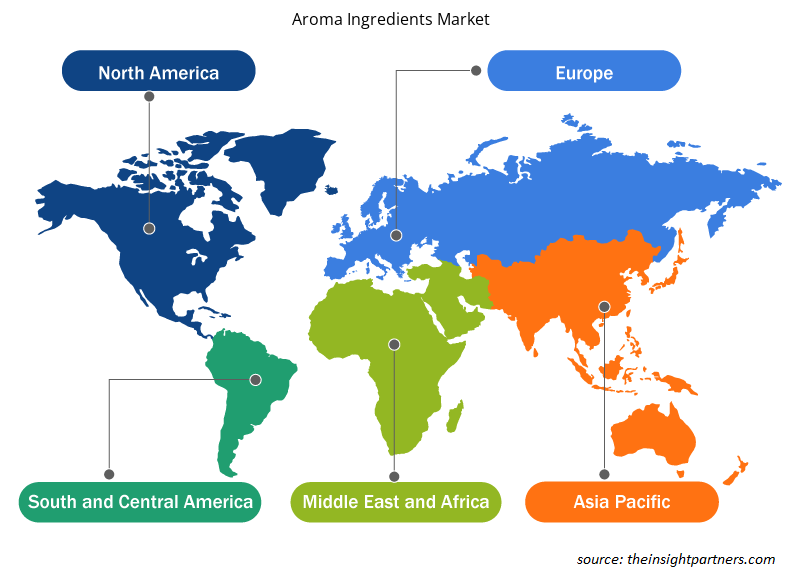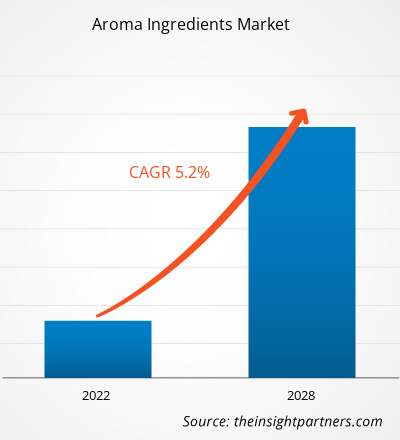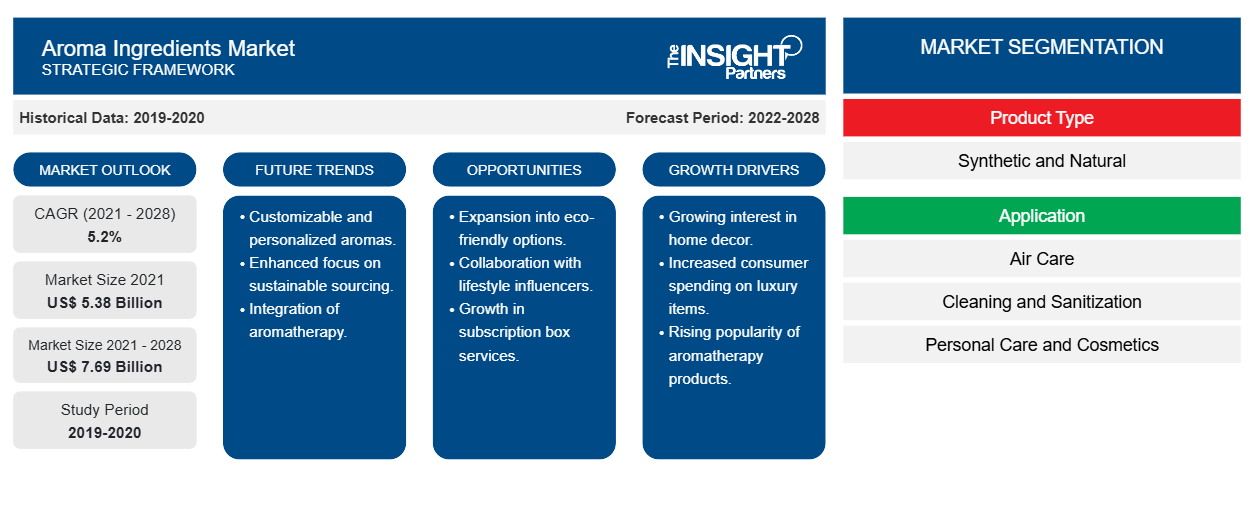بلغت قيمة سوق مكونات العطور 5376.90 مليون دولار أمريكي في عام 2021 ومن المتوقع أن تصل إلى 7692.62 مليون دولار أمريكي بحلول عام 2028؛ ومن المتوقع أن ينمو بمعدل نمو سنوي مركب قدره 5.2٪ من عام 2021 إلى عام 2028.
المكونات العطرية هي في الأساس مركبات معقدة تُضاف إلى مستحضرات التجميل والعناية الشخصية وكذلك منتجات العناية المنزلية وغيرها من المنتجات لإضفاء العطر المرغوب. يمكن أن تكون المكونات العطرية طبيعية أو صناعية. تشمل المكونات العطرية الزيوت العطرية والعطور والعزلات والراتنجات الزيتية والمطلقات والمواد الكيميائية العطرية ومكونات العطور الخاصة وغيرها. لقد وفرت صناعة العناية الشخصية ومستحضرات التجميل المتحولة العديد من فرص النمو الجديدة لسوق المكونات العطرية ومن المتوقع أن تدفع السوق خلال فترة التنبؤ.
في عام 2020، هيمنت منطقة آسيا والمحيط الهادئ على سوق مكونات الروائح العالمية ومن المتوقع أن تحتفظ بهيمنتها خلال فترة التنبؤ. في السنوات الأخيرة، كان هناك وعي متزايد فيما يتعلق بالمظهر الشخصي بين الأفراد في منطقة آسيا والمحيط الهادئ مما أدى إلى زيادة الطلب على منتجات التجميل مما أدى إلى نمو سوق مستحضرات التجميل في المنطقة. أدت الرغبة في الحصول على صورة شخصية قابلة للعرض بين المستهلكين الآسيويين إلى زيادة الوعي بعادات النظافة الشخصية. أدى قلق المستهلك المتزايد بشأن صحته ونظافته إلى زيادة الطلب على منتجات العناية الشخصية ومستحضرات التجميل بالإضافة إلى منتجات التنظيف والتطهير التي توفر العطر أو الرائحة، مما أدى بدوره إلى زيادة الطلب على مكونات الروائح. علاوة على ذلك، تتكون منطقة آسيا والمحيط الهادئ من دول مثل الهند والصين التي تحولت إلى مراكز تصنيع للعديد من أسواق الاستخدام النهائي التي تستخدم مكونات الروائح. أدى النمو السكاني في البلدان النامية في منطقة آسيا والمحيط الهادئ إلى جانب ارتفاع الدخل المتاح إلى زيادة الطلب على منتجات العناية الشخصية ومستحضرات التجميل. أدى الطلب إلى زيادة الإنتاج المحلي لمنتجات العناية الشخصية مما أدى إلى زيادة استهلاك مكونات الروائح في المنطقة.
قم بتخصيص هذا التقرير ليناسب متطلباتك
ستحصل على تخصيص لأي تقرير - مجانًا - بما في ذلك أجزاء من هذا التقرير، أو تحليل على مستوى الدولة، وحزمة بيانات Excel، بالإضافة إلى الاستفادة من العروض والخصومات الرائعة للشركات الناشئة والجامعات
- احصل على أهم اتجاهات السوق الرئيسية لهذا التقرير.ستتضمن هذه العينة المجانية تحليلاً للبيانات، بدءًا من اتجاهات السوق وحتى التقديرات والتوقعات.
رؤى السوق
استخدامات مختلفة لمكونات العطر
يؤدي الاستخدام المتزايد لمكونات الروائح في تطبيقات مختلفة مثل العناية بالهواء والعطور الفاخرة والمنتجات المنزلية والأغذية والمشروبات والأدوية إلى زيادة الطلب على مكونات الروائح. تشمل العطور الفاخرة مجالات تطبيق رئيسية، مثل العطور والكولونيا ورذاذ الجسم ومزيلات العرق. تعد مكونات الروائح أحد العناصر الأساسية المستخدمة في تركيبات العطور الفاخرة. إلى جانب ذلك، يتم استخدام مكونات الروائح في المنتجات المنزلية مثل المنظفات وسوائل غسل اليدين والأطباق والعناية بالغسيل ومنعمات الأقمشة والمناديل والأصباغ المائية. وبالتالي، فإن زيادة استخدام مكونات الروائح من شأنها أن تدفع نمو سوق مكونات الروائح.dishwashing liquids, laundry care and fabric softeners,
رؤى حول نوع المنتج
بناءً على نوع المنتج، يتم تقسيم سوق مكونات الروائح إلى طبيعية وصناعية. في عام 2020، كان القطاع الطبيعي هو القطاع الأسرع نموًا في سوق مكونات الروائح. أدت الزيادة في المخاوف الصحية المتعلقة بالمواد الكيميائية الصناعية إلى زيادة الطلب على مكونات الروائح الطبيعية من المستهلكين. ومع ذلك، فإن مكونات الروائح الصناعية أسهل نسبيًا في الإنتاج على نطاق واسع مع الحفاظ على نفس الجودة في جميع الدفعات. وبالتالي، أدت الجودة الثابتة للمكونات الصناعية إلى حصة سوقية أكبر بسبب الاستخدام الموسع خاصة في صناعة السلع الاستهلاكية سريعة الحركة.
تعد شركة Takasago International Corporation؛ وBASF SE؛ وFirmenich SA؛ وGivaudan SA؛ وInternational Flavors & Fragrances Inc.؛ وRobertet Group؛ وSymrise؛ وMane؛ وZhejiang NHU Co., Ltd.؛ وPhoenix Aromas & Essential Oils, LLC من بين اللاعبين الرئيسيين العاملين في سوق مكونات الروائح. يتبنى اللاعبون الرائدون العديد من الاستراتيجيات، مثل عمليات الدمج والاستحواذ وإطلاق المنتجات، لتوسيع حضورهم الجغرافي وقاعدة المستهلكين. International Corporation; BASF SE; Firmenich S.A.; Givaudan S.A.; International Flavors & Fragrances Inc.; Robertet Group; Symrise; Mane; Zhejiang NHU Co., Ltd.; and Phoenix Aromas & Essential Oils, LLC; are among the key players operating in the aroma ingredients market. The leading players adopt several strategies, such as mergers & acquisitions and product launches, to expand their geographic presence and consumer base.
رؤى إقليمية حول سوق مكونات الروائح
لقد قام المحللون في Insight Partners بشرح الاتجاهات والعوامل الإقليمية المؤثرة على سوق مكونات الروائح طوال فترة التوقعات بشكل شامل. يناقش هذا القسم أيضًا قطاعات سوق مكونات الروائح والجغرافيا في جميع أنحاء أمريكا الشمالية وأوروبا ومنطقة آسيا والمحيط الهادئ والشرق الأوسط وأفريقيا وأمريكا الجنوبية والوسطى.

- احصل على البيانات الإقليمية المحددة لسوق مكونات الروائح
نطاق تقرير سوق مكونات الروائح
| سمة التقرير | تفاصيل |
|---|---|
| حجم السوق في عام 2021 | 5.38 مليار دولار أمريكي |
| حجم السوق بحلول عام 2028 | 7.69 مليار دولار أمريكي |
| معدل النمو السنوي المركب العالمي (2021 - 2028) | 5.2% |
| البيانات التاريخية | 2019-2020 |
| فترة التنبؤ | 2022-2028 |
| القطاعات المغطاة | حسب نوع المنتج
|
| المناطق والدول المغطاة | أمريكا الشمالية
|
| قادة السوق وملفات تعريف الشركات الرئيسية |
|
كثافة اللاعبين في سوق مكونات الروائح: فهم تأثيرها على ديناميكيات الأعمال
يشهد سوق مكونات الروائح نموًا سريعًا، مدفوعًا بالطلب المتزايد من المستخدم النهائي بسبب عوامل مثل تفضيلات المستهلك المتطورة والتقدم التكنولوجي والوعي المتزايد بفوائد المنتج. ومع ارتفاع الطلب، تعمل الشركات على توسيع عروضها والابتكار لتلبية احتياجات المستهلكين والاستفادة من الاتجاهات الناشئة، مما يؤدي إلى زيادة نمو السوق.
تشير كثافة اللاعبين في السوق إلى توزيع الشركات أو المؤسسات العاملة في سوق أو صناعة معينة. وهي تشير إلى عدد المنافسين (اللاعبين في السوق) الموجودين في مساحة سوق معينة نسبة إلى حجمها أو قيمتها السوقية الإجمالية.
الشركات الرئيسية العاملة في سوق مكونات الروائح هي:
- شركة تاكاساجو الدولية
- باسف اس اي
- شركة فيرمينيش المحدودة
- جيفودان إس إيه
- الشركة العالمية للنكهات والعطور
إخلاء المسؤولية : الشركات المذكورة أعلاه ليست مرتبة بأي ترتيب معين.

- احصل على نظرة عامة على أهم اللاعبين الرئيسيين في سوق مكونات الروائح
تقرير يسلط الضوء على
- اتجاهات تقدمية في صناعة مكونات الروائح لمساعدة اللاعبين على تطوير استراتيجيات فعالة طويلة الأجل
- استراتيجيات نمو الأعمال التي تتبناها الشركات لضمان النمو في الأسواق المتقدمة والنامية
- التحليل الكمي لسوق مكونات الروائح العالمية من 2019 إلى 2028
- تقدير الطلب على مكونات العطور عبر مختلف الصناعات
- تحليل بورتر لتوضيح مدى فعالية المشترين والموردين العاملين في الصناعة للتنبؤ بنمو السوق
- التطورات الأخيرة لفهم سيناريو السوق التنافسي والطلب على مكونات العطر
- اتجاهات السوق والتوقعات إلى جانب العوامل التي تدفع وتكبح نمو سوق مكونات العطور
- فهم الاستراتيجيات التي تدعم الاهتمام التجاري فيما يتعلق بنمو سوق مكونات الروائح العالمية، مما يساعد في عملية اتخاذ القرار
- حجم سوق مكونات الروائح في مختلف مناطق السوق
- نظرة عامة تفصيلية وتقسيم السوق العالمية لمكونات الروائح بالإضافة إلى ديناميكيات صناعتها
- حجم سوق مكونات الروائح في مناطق مختلفة مع فرص نمو واعدة
"تحليل سوق مكونات الروائح العالمية حتى عام 2028" هو دراسة متخصصة ومتعمقة لصناعة المواد الكيميائية والمواد مع التركيز بشكل خاص على تحليل اتجاه سوق مكونات الروائح العالمية. يهدف التقرير إلى تقديم نظرة عامة على السوق مع تقسيم السوق بالتفصيل. يتم تقسيم سوق مكونات الروائح على أساس نوع المنتج والتطبيق والجغرافيا. بناءً على نوع المنتج، يتم تقسيم السوق إلى طبيعي وصناعي. بناءً على التطبيق، يتم تقسيم السوق إلى العناية بالهواء والتنظيف والتطهير والعناية الشخصية ومستحضرات التجميل والعطور الفاخرة وغيرها. بناءً على الجغرافيا، يتم تقسيم السوق إلى خمس مناطق رئيسية - أمريكا الشمالية وأوروبا وآسيا والمحيط الهادئ والشرق الأوسط وأفريقيا وأمريكا الجنوبية والوسطى.
نبذة عن الشركة
- شركة تاكاساجو الدولية
- باسف اس اي
- شركة فيرمينيش المحدودة
- جيفودان إس إيه
- الشركة العالمية للنكهات والعطور
- مجموعة روبرتيت
- سيمرايز
- بدة
- شركة تشجيانغ NHU المحدودة
- فينيكس للعطور والزيوت العطرية، ذ.م.م.
- التحليل التاريخي (سنتان)، سنة الأساس، التوقعات (7 سنوات) مع معدل النمو السنوي المركب
- تحليل PEST و SWOT
- حجم السوق والقيمة / الحجم - عالمي، إقليمي، بلد
- الصناعة والمنافسة
- مجموعة بيانات إكسل
التقارير الحديثة
شهادات العملاء
سبب الشراء
- اتخاذ قرارات مدروسة
- فهم ديناميكيات السوق
- تحليل المنافسة
- رؤى العملاء
- توقعات السوق
- تخفيف المخاطر
- التخطيط الاستراتيجي
- مبررات الاستثمار
- تحديد الأسواق الناشئة
- تحسين استراتيجيات التسويق
- تعزيز الكفاءة التشغيلية
- مواكبة التوجهات التنظيمية























 احصل على عينة مجانية ل - سوق مكونات الروائح
احصل على عينة مجانية ل - سوق مكونات الروائح